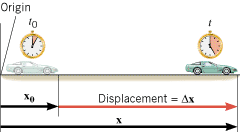
2.1. Displacement
There are two aspects to any motion. In a purely descriptive sense, there is the movement itself. Is it rapid or slow, for instance? Then, there is the issue of what causes the motion or what changes it, which requires that forces be considered. Kinematics deals with the concepts that are needed to describe motion, without any reference to forces. The present chapter discusses these concepts as they apply to motion in one dimension, and the next chapter treats two-dimensional motion. Dynamics deals with the effect that forces have on motion, a topic that is considered in Chapter 4. Together, kinematics and dynamics form the branch of physics known as mechanics. We turn now to the first of the kinematics concepts to be discussed, which is displacement.
To describe the motion of an object, we must be able to specify the location of the object at all times, and Figure 2.1 shows how to do this for one-dimensional motion. In this drawing, the initial position of a car is indicated by the vector labeled x0. The length of x0 is the distance of the car from an arbitrarily chosen origin. At a later time the car has moved to a new position, which is indicated by the vector x. The displacement of the car Dx (read as “delta x” or “the change in x”) is a vector drawn from the initial position to the final position. Displacement is a vector quantity in the sense discussed in Section 1.5, for it conveys both a magnitude (the distance between the initial and final positions) and a direction. The displacement can be related to x0 and x by noting from the drawing that
 |
Thus, the displacement Dx is the difference between x and x0, and the Greek letter delta (D) is used to signify this difference. It is important to note that the change in any variable is always the final value minus the initial value.
 |
|
| DEFINITION OF DISPLACEMENT |
|
The displacement is a vector that points from an object’s initial position to its final position and has a magnitude that equals the shortest distance between the two positions. SI Unit of Displacement: meter (m) |
The SI unit for displacement is the meter (m), but there are other units as well, such as the centimeter and the inch. When converting between centimeters (cm) and inches (in.), remember that 2.54 cm![]() =
=![]() 1 in.
1 in.
Often, we will deal with motion along a straight line. In such a case, a displacement in one direction along the line is assigned a positive value, and a displacement in the opposite direction is assigned a negative value. For instance, assume that a car is moving along an east/west direction and that a positive (+) sign is used to denote a direction due east. Then, Dx![]() =
=![]() +500 m represents a displacement that points to the east and has a magnitude of 500 meters. Conversely, Dx
+500 m represents a displacement that points to the east and has a magnitude of 500 meters. Conversely, Dx![]() =
=![]() –500 m is a displacement that has the same magnitude but points in the opposite direction, due west.
–500 m is a displacement that has the same magnitude but points in the opposite direction, due west.